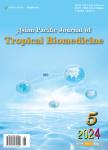Effect of nettle(Urtica dioica) extract on gentamicin induced nephrotoxicity in male rabbits
Effect of nettle(Urtica dioica) extract on gentamicin induced nephrotoxicity in male rabbits作者机构:Pharmacology Department of Basic Sciences College of Veterinary Medicine University of Sulaimani
出 版 物:《Asian Pacific Journal of Tropical Biomedicine》 (亚太热带生物医学杂志(英文版))
年 卷 期:2015年第5卷第9期
页 面:729-732页
学科分类:0710[理学-生物学] 0831[工学-生物医学工程(可授工学、理学、医学学位)] 1008[医学-中药学(可授医学、理学学位)] 1006[医学-中西医结合] 100602[医学-中西医结合临床] 10[医学]
主 题:Antioxidant activity Nettle Urtica dioica Gentamicin Herbal medicine Histopathological study and nephrotoxicity
摘 要:Objective:To investigate the antioxidant ef ect of an orally administered ethanol extract of nettle(Urtica dioica) and its protective role in preventing or ameliorating oxidative stress as a major factor in gentamicin-induced nephrotoxicity in male rabbits. Methods: Twenty rabbits were divided into 4 equal groups:(G1) control group,(G2) gentamicin treated group(100 mg/kg),(G3) nettle treated group(100 mg/kg),(G4) combination treated group with both gentamicin(100 mg/kg) and nettle(100 mg/kg) for 10 days. The antioxidant properties of nettle were evaluated using dif erent antioxidant tests, such as determination of glutathione and malondialdehyde levels and total phenolic content analysis. Results: Biochemical and histopathological study revealed that gentamicin caused nephrotoxicity observed clearly in the histopathological section of the kidney in the gentamicin treated group. Serum creatinine and blood urea nitrogen were biochemical indicators for nephrotoxicity which increased signii cantly in gentamicin treated group; other groups have no signii cant change in these two parameters. Nettle extract protected the rabbits from alteration in the level of blood urea nitrogen and serum creatinine when given after inducing of gentamicin nephrotoxicity. The nettle treated group showed a great ef ect as an antioxidant factor by increasing the glutathione level and reducing malondialdehyde level. No signii cant changes in biochemical parameters and no renal histopathological changes observed in the groups treated with nettle extract, which meant nettle had powerful antioxidant activity. Conclusions: Therefore, it can be assumed that the nephroprotective ef ect shown by nettle in gentamicin-induced nephrotoxicity can reserve intracellular levels of biological pathways and supportively enhance excretion of toxic levels of gentamicin.



